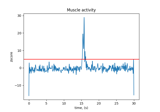mne.preprocessing.annotate_muscle_zscore#
- mne.preprocessing.annotate_muscle_zscore(raw, threshold=4, ch_type=None, min_length_good=0.1, filter_freq=(110, 140), n_jobs=None, verbose=None)[source]#
Create annotations for segments that likely contain muscle artifacts.
Detects data segments containing activity in the frequency range given by
filter_freqwhose envelope magnitude exceeds the specified z-score threshold, when summed across channels and divided bysqrt(n_channels). False-positive transient peaks are prevented by low-pass filtering the resulting z-score time series at 4 Hz. Only operates on a single channel type, ifch_typeisNoneit will select the first type in the listmag,grad,eeg. See [1] for background on choosingfilter_freqandthreshold.- Parameters:
- rawinstance of
Raw Data to estimate segments with muscle artifacts.
- threshold
float The threshold in z-scores for marking segments as containing muscle activity artifacts.
- ch_type‘mag’ | ‘grad’ | ‘eeg’ |
None The type of sensors to use. If
Noneit will take the first type inmag,grad,eeg.- min_length_good
float|None The shortest allowed duration of “good data” (in seconds) between adjacent annotations; shorter segments will be incorporated into the surrounding annotations.``None`` is equivalent to
0. Default is0.1.- filter_freqarray_like, shape (2,)
The lower and upper frequencies of the band-pass filter. Default is
(110, 140).- n_jobs
int|None The number of jobs to run in parallel. If
-1, it is set to the number of CPU cores. Requires thejoblibpackage.None(default) is a marker for ‘unset’ that will be interpreted asn_jobs=1(sequential execution) unless the call is performed under ajoblib.parallel_configcontext manager that sets another value forn_jobs.- verbosebool |
str|int|None Control verbosity of the logging output. If
None, use the default verbosity level. See the logging documentation andmne.verbose()for details. Should only be passed as a keyword argument.
- rawinstance of
- Returns:
- annot
mne.Annotations Periods with muscle artifacts annotated as BAD_muscle.
- scores_muscle
array Z-score values averaged across channels for each sample.
- annot
References
